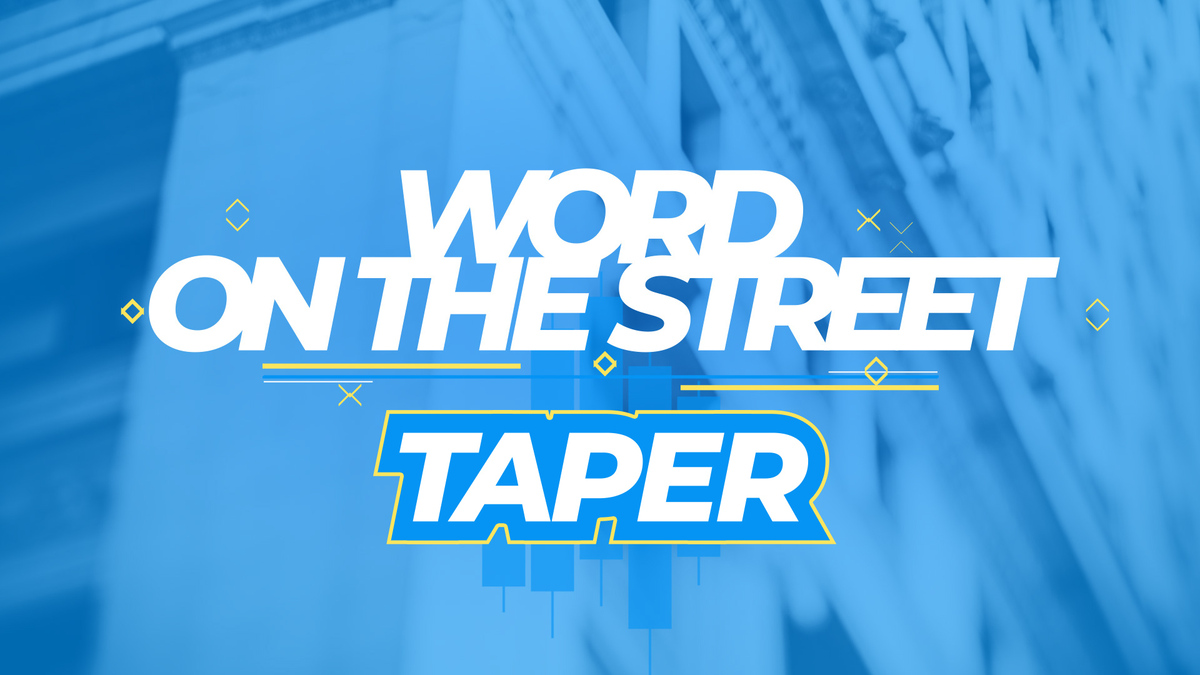
SIMONE DEL ROSARIO: ALL OF WALL STREET’S BEEN BUZZING ABOUT IT. AND AFTER A YEAR OF SPECULATION…
JEROME POWELL: IT IS TIME TO TAPER WE THINK BECAUSE THE ECONOMY HAS ACHIEVED SUBSTANTIAL FURTHER PROGRESS TOWARD OUR GOALS.
SIMONE DEL ROSARIO: SO NOW THAT TAPERING IS OFFICIALLY A GO, WHAT EXACTLY DOES “TAPER” MEAN? AND HOW DOES IT AFFECT YOU? WE’RE DIGGING INTO THAT IN TODAY’S WORD ON THE STREET.
TAPER IS THE GRADUAL SLOWING DOWN OF CENTRAL BANK PURCHASES OF SECURITIES AND BONDS. BASICALLY, WHEN THE ECONOMY IS IN DEEP TROUBLE, LIKE A RECESSION, THE FEDERAL RESERVE STARTS BUYING UP BONDS TO INFUSE MORE MONEY INTO THE FINANCIAL SYSTEM. THIS GIVES BANKS MORE MONEY TO WORK WITH, WHICH ENCOURAGES LENDING AND INVESTMENT. IT ALSO HELPS DRIVE DOWN INTEREST RATES, LIKE THAT 30-YEAR MORTGAGE YOU GOT FOR UNDER THREE PERCENT.
SO WHEN THE PANDEMIC SENT SHOCKWAVES THROUGH THE U.S. ECONOMY, THE FED INITIALLY BOUGHT MORE THAN A TRILLION DOLLARS IN BONDS TO CALM THE MARKETS. BY JUNE 2020, THEY SETTLED INTO A RHYTHM OF BUYING $120 BILLION A MONTH IN BONDS AND THEY’VE DONE THAT EVERY MONTH SINCE.
JEROME POWELL: OUR ASSET PURCHASES HAVE BEEN A CRITICAL TOOL. THEY HELPED PRESERVE FINANCIAL STABILITY EARLY IN THE PANDEMIC.
SIMONE DEL ROSARIO: BUT THERE’S DANGER OF CONTINUING THIS PRACTICE WHEN THE ECONOMY HAS RECOVERED.
ED YARDENI: WHEN YOU POUR IN A LOT OF MONEY INTO THE ECONOMY AND POUR IT IN FASTER THAN THE ECONOMY IS GROWING, YOU CAN GET INFLATION.
SIMONE DEL ROSARIO: SO NOW IT’S TIME TO TURN OFF THE TAP.
ED YARDENI: THEY JUST ANNOUNCED THAT THEY’RE GOING TO TAPER AND ALL THAT MEANS IS BUY BONDS AT A SLOWER PACE.
SIMONE DEL ROSARIO: STARTING IN NOVEMBER, THE FED’S PLAN IS TO REDUCE, OR TAPER, ITS MONTHLY BOND PURCHASES BY 15 BILLION EACH MONTH UNTIL IT HITS ZERO. WHY THE SLOW DRAWDOWN?
WELL, PULL THE PLUG TOO QUICK, AND THE FED COULD TRIGGER A TAPER TANTRUM. THAT’S WHEN THE MARKET COLLECTIVELY PANICS AT THE THOUGHT OF TAPERING.
ED YARDENI: THIS TIME AROUND, THEY’VE BEEN SIGNALING THAT THEY’RE GOING TO TAPER FOR SO LONG, THAT IT’S LIKE, OKAY, YOU KNOW, WE ACCEPT IT, AND NOBODY’S HAVING A TANTRUM ABOUT IT.
SIMONE DEL ROSARIO: SO THE USUAL MARKET VOLATILITY HASN’T HAPPENED THIS TIME. AT LEAST NOT YET. WHAT ELSE DOES TAPERING MEAN FOR YOU?
IT TENDS TO DRIVE UP LONG-TERM INTEREST RATES, WHICH MEANS MORTGAGES AND OTHER LOANS BECOME MORE EXPENSIVE.
ON THE PLUS SIDE, TAPERING GENERALLY COOLS INFLATION, WHICH MEANS COST OF LIVING BECOMES MORE AFFORDABLE.
NOW THAT YOU KNOW WHAT IT MEANS TO TAPER, WHAT OTHER TERMS DO YOU WANT TO HEAR ABOUT IN OUR WORD ON THE STREET? LET ME KNOW IN THE COMMENTS BELOW.






